Analyzing Gender Disparities in Australian Workplace Environments
VerifiedAdded on 2021/06/17
|10
|1799
|28
Report
AI Summary
This research report investigates gender discrimination in Australian workplaces, focusing on salary disparities and employment patterns. The study utilizes data from the Australian Taxation Office (ATO) to analyze the distribution of males and females across various occupations and assess potential biases in pay and employment opportunities. The report presents summary statistics, including tables and graphs illustrating the distribution of genders across different occupations, and correlation analyses examining the relationship between gender and salary. Inferential statistics, such as t-tests and tests for sample proportions, are employed to determine if there are significant differences in salaries between genders and to assess the representation of males and females in specific roles. The findings reveal insights into gender inequality in the Australian workforce, highlighting the distribution of genders across various occupations and assessing potential biases in pay and employment opportunities, and the implications of these findings are discussed in the context of existing literature on gender discrimination. The report concludes with recommendations for future research and strategies to address gender-based disparities in the workplace.

Research 1
Name
Tutor
Institution
Date
Name
Tutor
Institution
Date
Paraphrase This Document
Need a fresh take? Get an instant paraphrase of this document with our AI Paraphraser
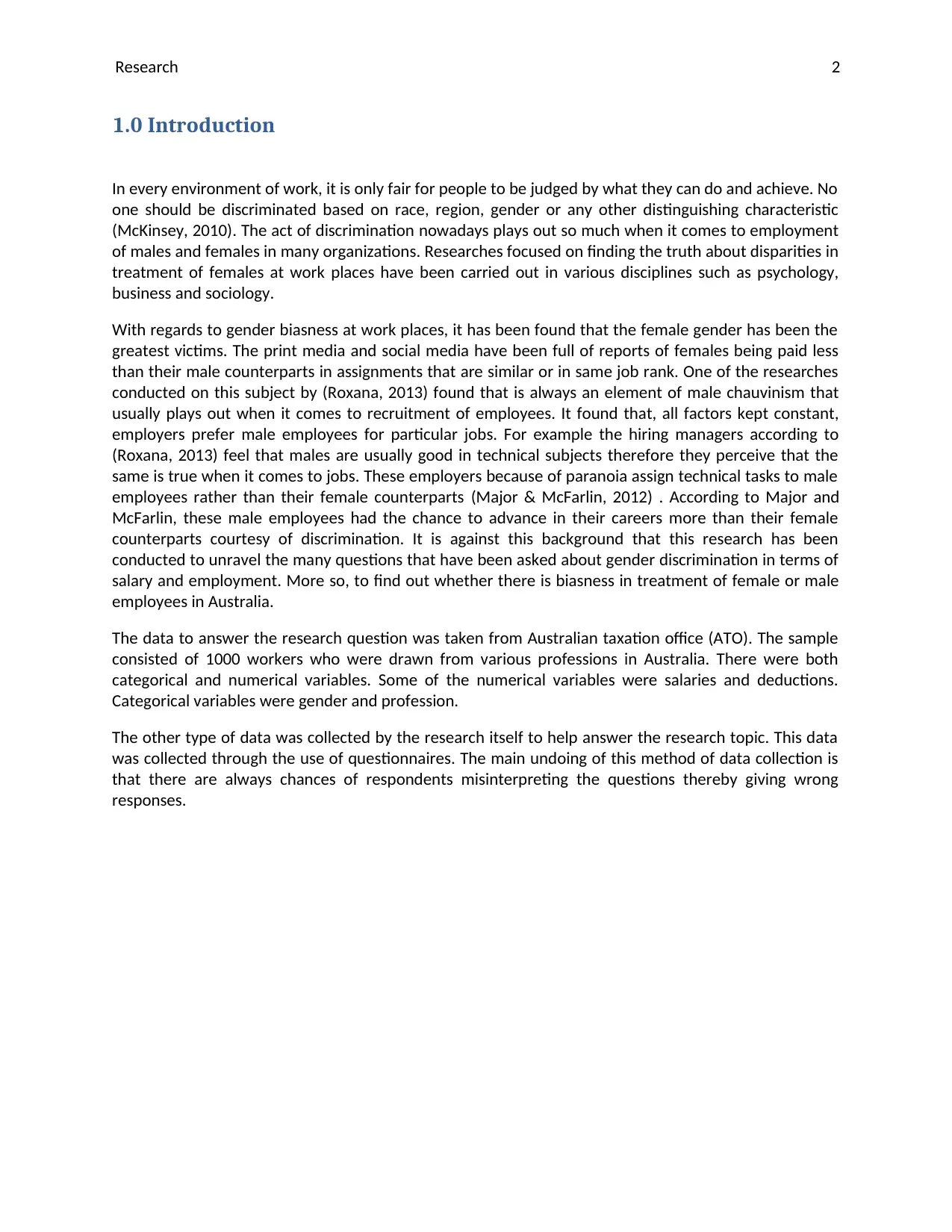
Research 2
1.0 Introduction
In every environment of work, it is only fair for people to be judged by what they can do and achieve. No
one should be discriminated based on race, region, gender or any other distinguishing characteristic
(McKinsey, 2010). The act of discrimination nowadays plays out so much when it comes to employment
of males and females in many organizations. Researches focused on finding the truth about disparities in
treatment of females at work places have been carried out in various disciplines such as psychology,
business and sociology.
With regards to gender biasness at work places, it has been found that the female gender has been the
greatest victims. The print media and social media have been full of reports of females being paid less
than their male counterparts in assignments that are similar or in same job rank. One of the researches
conducted on this subject by (Roxana, 2013) found that is always an element of male chauvinism that
usually plays out when it comes to recruitment of employees. It found that, all factors kept constant,
employers prefer male employees for particular jobs. For example the hiring managers according to
(Roxana, 2013) feel that males are usually good in technical subjects therefore they perceive that the
same is true when it comes to jobs. These employers because of paranoia assign technical tasks to male
employees rather than their female counterparts (Major & McFarlin, 2012) . According to Major and
McFarlin, these male employees had the chance to advance in their careers more than their female
counterparts courtesy of discrimination. It is against this background that this research has been
conducted to unravel the many questions that have been asked about gender discrimination in terms of
salary and employment. More so, to find out whether there is biasness in treatment of female or male
employees in Australia.
The data to answer the research question was taken from Australian taxation office (ATO). The sample
consisted of 1000 workers who were drawn from various professions in Australia. There were both
categorical and numerical variables. Some of the numerical variables were salaries and deductions.
Categorical variables were gender and profession.
The other type of data was collected by the research itself to help answer the research topic. This data
was collected through the use of questionnaires. The main undoing of this method of data collection is
that there are always chances of respondents misinterpreting the questions thereby giving wrong
responses.
1.0 Introduction
In every environment of work, it is only fair for people to be judged by what they can do and achieve. No
one should be discriminated based on race, region, gender or any other distinguishing characteristic
(McKinsey, 2010). The act of discrimination nowadays plays out so much when it comes to employment
of males and females in many organizations. Researches focused on finding the truth about disparities in
treatment of females at work places have been carried out in various disciplines such as psychology,
business and sociology.
With regards to gender biasness at work places, it has been found that the female gender has been the
greatest victims. The print media and social media have been full of reports of females being paid less
than their male counterparts in assignments that are similar or in same job rank. One of the researches
conducted on this subject by (Roxana, 2013) found that is always an element of male chauvinism that
usually plays out when it comes to recruitment of employees. It found that, all factors kept constant,
employers prefer male employees for particular jobs. For example the hiring managers according to
(Roxana, 2013) feel that males are usually good in technical subjects therefore they perceive that the
same is true when it comes to jobs. These employers because of paranoia assign technical tasks to male
employees rather than their female counterparts (Major & McFarlin, 2012) . According to Major and
McFarlin, these male employees had the chance to advance in their careers more than their female
counterparts courtesy of discrimination. It is against this background that this research has been
conducted to unravel the many questions that have been asked about gender discrimination in terms of
salary and employment. More so, to find out whether there is biasness in treatment of female or male
employees in Australia.
The data to answer the research question was taken from Australian taxation office (ATO). The sample
consisted of 1000 workers who were drawn from various professions in Australia. There were both
categorical and numerical variables. Some of the numerical variables were salaries and deductions.
Categorical variables were gender and profession.
The other type of data was collected by the research itself to help answer the research topic. This data
was collected through the use of questionnaires. The main undoing of this method of data collection is
that there are always chances of respondents misinterpreting the questions thereby giving wrong
responses.
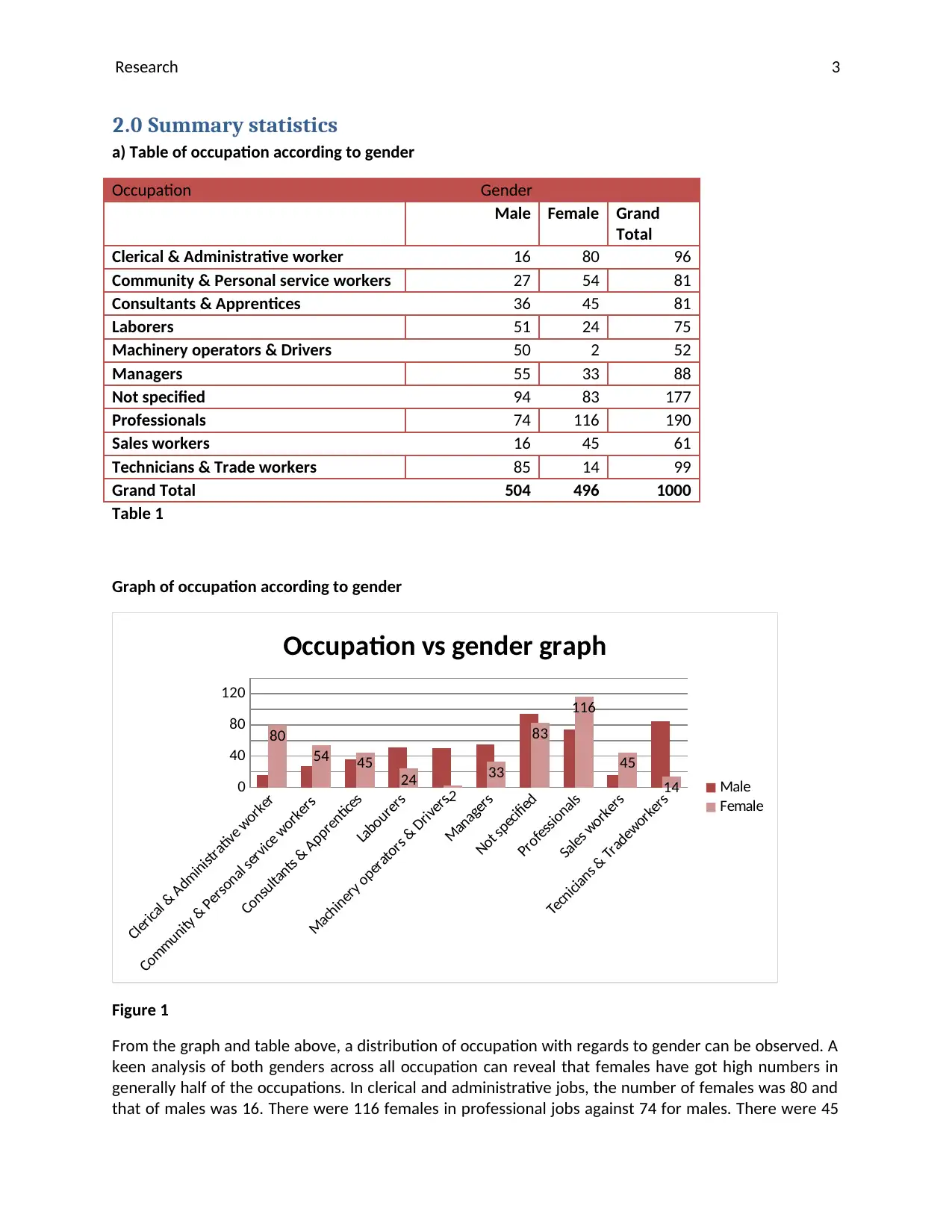
Research 3
2.0 Summary statistics
a) Table of occupation according to gender
Occupation Gender
Male Female Grand
Total
Clerical & Administrative worker 16 80 96
Community & Personal service workers 27 54 81
Consultants & Apprentices 36 45 81
Laborers 51 24 75
Machinery operators & Drivers 50 2 52
Managers 55 33 88
Not specified 94 83 177
Professionals 74 116 190
Sales workers 16 45 61
Technicians & Trade workers 85 14 99
Grand Total 504 496 1000
Table 1
Graph of occupation according to gender
Clerical & Administrative worker
Community & Personal service workers
Consultants & Apprentices
Labourers
Machinery operators & Drivers
Managers
Not specified
Professionals
Sales workers
Tecnicians & Tradeworkers
0
40
80
120
80
54 45
24
2
33
83
116
45
14
Occupation vs gender graph
Male
Female
Figure 1
From the graph and table above, a distribution of occupation with regards to gender can be observed. A
keen analysis of both genders across all occupation can reveal that females have got high numbers in
generally half of the occupations. In clerical and administrative jobs, the number of females was 80 and
that of males was 16. There were 116 females in professional jobs against 74 for males. There were 45
2.0 Summary statistics
a) Table of occupation according to gender
Occupation Gender
Male Female Grand
Total
Clerical & Administrative worker 16 80 96
Community & Personal service workers 27 54 81
Consultants & Apprentices 36 45 81
Laborers 51 24 75
Machinery operators & Drivers 50 2 52
Managers 55 33 88
Not specified 94 83 177
Professionals 74 116 190
Sales workers 16 45 61
Technicians & Trade workers 85 14 99
Grand Total 504 496 1000
Table 1
Graph of occupation according to gender
Clerical & Administrative worker
Community & Personal service workers
Consultants & Apprentices
Labourers
Machinery operators & Drivers
Managers
Not specified
Professionals
Sales workers
Tecnicians & Tradeworkers
0
40
80
120
80
54 45
24
2
33
83
116
45
14
Occupation vs gender graph
Male
Female
Figure 1
From the graph and table above, a distribution of occupation with regards to gender can be observed. A
keen analysis of both genders across all occupation can reveal that females have got high numbers in
generally half of the occupations. In clerical and administrative jobs, the number of females was 80 and
that of males was 16. There were 116 females in professional jobs against 74 for males. There were 45
⊘ This is a preview!⊘
Do you want full access?
Subscribe today to unlock all pages.

Trusted by 1+ million students worldwide
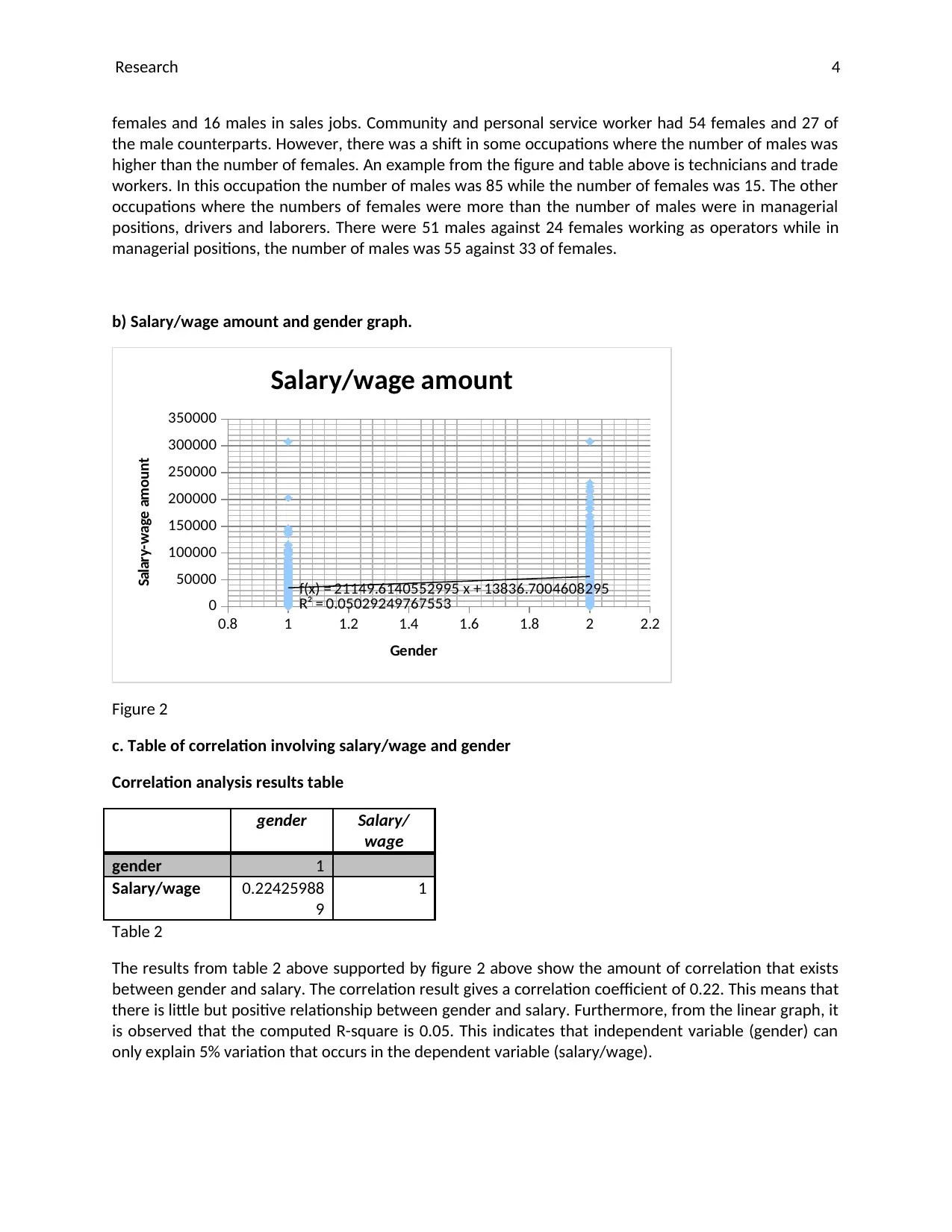
Research 4
females and 16 males in sales jobs. Community and personal service worker had 54 females and 27 of
the male counterparts. However, there was a shift in some occupations where the number of males was
higher than the number of females. An example from the figure and table above is technicians and trade
workers. In this occupation the number of males was 85 while the number of females was 15. The other
occupations where the numbers of females were more than the number of males were in managerial
positions, drivers and laborers. There were 51 males against 24 females working as operators while in
managerial positions, the number of males was 55 against 33 of females.
b) Salary/wage amount and gender graph.
0.8 1 1.2 1.4 1.6 1.8 2 2.2
0
50000
100000
150000
200000
250000
300000
350000
f(x) = 21149.6140552995 x + 13836.7004608295
R² = 0.05029249767553
Salary/wage amount
Gender
Salary-wage amount
Figure 2
c. Table of correlation involving salary/wage and gender
Correlation analysis results table
gender Salary/
wage
gender 1
Salary/wage 0.22425988
9
1
Table 2
The results from table 2 above supported by figure 2 above show the amount of correlation that exists
between gender and salary. The correlation result gives a correlation coefficient of 0.22. This means that
there is little but positive relationship between gender and salary. Furthermore, from the linear graph, it
is observed that the computed R-square is 0.05. This indicates that independent variable (gender) can
only explain 5% variation that occurs in the dependent variable (salary/wage).
females and 16 males in sales jobs. Community and personal service worker had 54 females and 27 of
the male counterparts. However, there was a shift in some occupations where the number of males was
higher than the number of females. An example from the figure and table above is technicians and trade
workers. In this occupation the number of males was 85 while the number of females was 15. The other
occupations where the numbers of females were more than the number of males were in managerial
positions, drivers and laborers. There were 51 males against 24 females working as operators while in
managerial positions, the number of males was 55 against 33 of females.
b) Salary/wage amount and gender graph.
0.8 1 1.2 1.4 1.6 1.8 2 2.2
0
50000
100000
150000
200000
250000
300000
350000
f(x) = 21149.6140552995 x + 13836.7004608295
R² = 0.05029249767553
Salary/wage amount
Gender
Salary-wage amount
Figure 2
c. Table of correlation involving salary/wage and gender
Correlation analysis results table
gender Salary/
wage
gender 1
Salary/wage 0.22425988
9
1
Table 2
The results from table 2 above supported by figure 2 above show the amount of correlation that exists
between gender and salary. The correlation result gives a correlation coefficient of 0.22. This means that
there is little but positive relationship between gender and salary. Furthermore, from the linear graph, it
is observed that the computed R-square is 0.05. This indicates that independent variable (gender) can
only explain 5% variation that occurs in the dependent variable (salary/wage).
Paraphrase This Document
Need a fresh take? Get an instant paraphrase of this document with our AI Paraphraser

Research 5
d. Graph of relationship involving salary and gift amount
0 50000 100000 150000 200000 250000 300000 350000
0
20000
40000
60000
80000
100000
120000
140000
160000
f(x) = − 0.000230000027042235 x + 282.720516834362
R² = 5.16161091790312E-06
Salary versus Gift amount
Gift amount
Salary wage
Figure 3
The scatterplot above is a representation of the relationship between salary amounts and gift amount. It
can be observed that there negligible negative relationship between the two variables. This can be
confirmed by the coefficient of independent variable gift (-0.0002). The value of R-square is also zero.
This means that the independent variable is not responsible for any variation that occurs in the
dependent variable.
3.0 Inferential statistics
a) Top 4 occupations according to median salary
managers
Mean 83416.784
1
Standard
Error
5971.9279
3
female 33
Median 72401.5 total 88
Mode 0 proportio
n
0.375
Table 3
Technicians & Trade workers
female 14
Mean 69624.4040
4
total 99
Standard 4447.82987 proportio 0.14
d. Graph of relationship involving salary and gift amount
0 50000 100000 150000 200000 250000 300000 350000
0
20000
40000
60000
80000
100000
120000
140000
160000
f(x) = − 0.000230000027042235 x + 282.720516834362
R² = 5.16161091790312E-06
Salary versus Gift amount
Gift amount
Salary wage
Figure 3
The scatterplot above is a representation of the relationship between salary amounts and gift amount. It
can be observed that there negligible negative relationship between the two variables. This can be
confirmed by the coefficient of independent variable gift (-0.0002). The value of R-square is also zero.
This means that the independent variable is not responsible for any variation that occurs in the
dependent variable.
3.0 Inferential statistics
a) Top 4 occupations according to median salary
managers
Mean 83416.784
1
Standard
Error
5971.9279
3
female 33
Median 72401.5 total 88
Mode 0 proportio
n
0.375
Table 3
Technicians & Trade workers
female 14
Mean 69624.4040
4
total 99
Standard 4447.82987 proportio 0.14
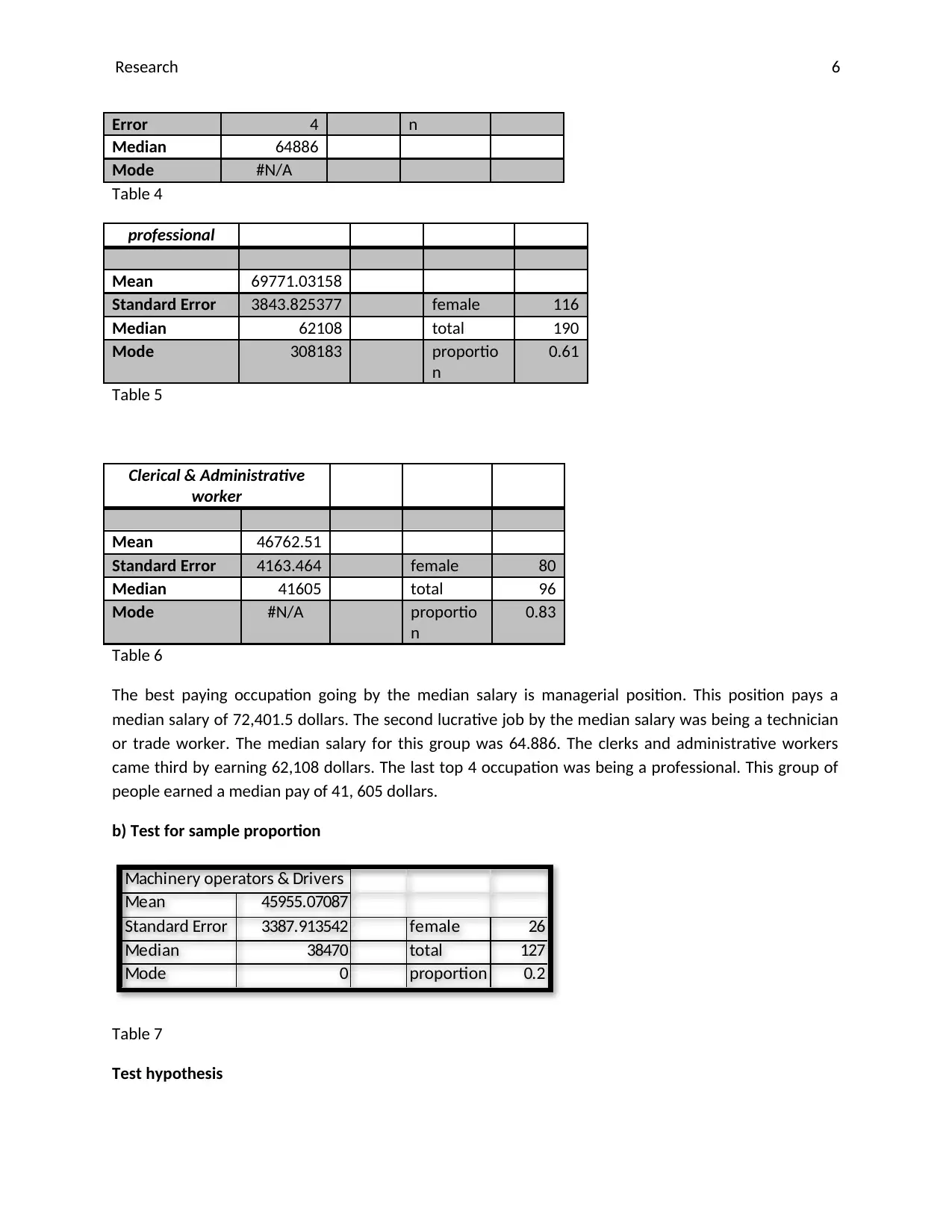
Research 6
Error 4 n
Median 64886
Mode #N/A
Table 4
professional
Mean 69771.03158
Standard Error 3843.825377 female 116
Median 62108 total 190
Mode 308183 proportio
n
0.61
Table 5
Clerical & Administrative
worker
Mean 46762.51
Standard Error 4163.464 female 80
Median 41605 total 96
Mode #N/A proportio
n
0.83
Table 6
The best paying occupation going by the median salary is managerial position. This position pays a
median salary of 72,401.5 dollars. The second lucrative job by the median salary was being a technician
or trade worker. The median salary for this group was 64.886. The clerks and administrative workers
came third by earning 62,108 dollars. The last top 4 occupation was being a professional. This group of
people earned a median pay of 41, 605 dollars.
b) Test for sample proportion
Table 7
Test hypothesis
Machinery operators & Drivers
Mean 45955.07087
Standard Error 3387.913542 female 26
Median 38470 total 127
Mode 0 proportion 0.2
Error 4 n
Median 64886
Mode #N/A
Table 4
professional
Mean 69771.03158
Standard Error 3843.825377 female 116
Median 62108 total 190
Mode 308183 proportio
n
0.61
Table 5
Clerical & Administrative
worker
Mean 46762.51
Standard Error 4163.464 female 80
Median 41605 total 96
Mode #N/A proportio
n
0.83
Table 6
The best paying occupation going by the median salary is managerial position. This position pays a
median salary of 72,401.5 dollars. The second lucrative job by the median salary was being a technician
or trade worker. The median salary for this group was 64.886. The clerks and administrative workers
came third by earning 62,108 dollars. The last top 4 occupation was being a professional. This group of
people earned a median pay of 41, 605 dollars.
b) Test for sample proportion
Table 7
Test hypothesis
Machinery operators & Drivers
Mean 45955.07087
Standard Error 3387.913542 female 26
Median 38470 total 127
Mode 0 proportion 0.2
⊘ This is a preview!⊘
Do you want full access?
Subscribe today to unlock all pages.

Trusted by 1+ million students worldwide
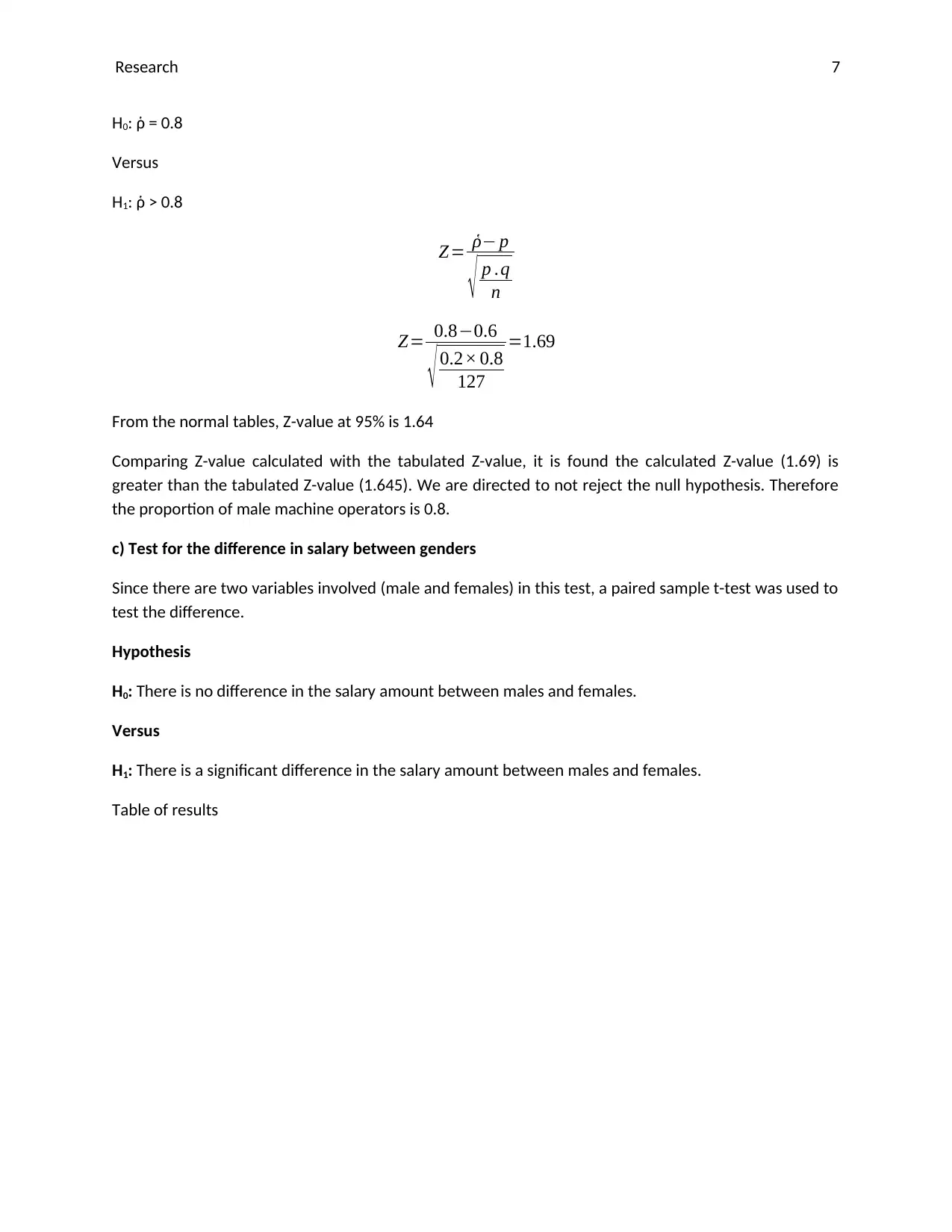
Research 7
H0: ῥ = 0.8
Versus
H1: ῥ > 0.8
Z= ῥ− p
√ p .q
n
Z= 0.8−0.6
√ 0.2× 0.8
127
=1.69
From the normal tables, Z-value at 95% is 1.64
Comparing Z-value calculated with the tabulated Z-value, it is found the calculated Z-value (1.69) is
greater than the tabulated Z-value (1.645). We are directed to not reject the null hypothesis. Therefore
the proportion of male machine operators is 0.8.
c) Test for the difference in salary between genders
Since there are two variables involved (male and females) in this test, a paired sample t-test was used to
test the difference.
Hypothesis
H0: There is no difference in the salary amount between males and females.
Versus
H1: There is a significant difference in the salary amount between males and females.
Table of results
H0: ῥ = 0.8
Versus
H1: ῥ > 0.8
Z= ῥ− p
√ p .q
n
Z= 0.8−0.6
√ 0.2× 0.8
127
=1.69
From the normal tables, Z-value at 95% is 1.64
Comparing Z-value calculated with the tabulated Z-value, it is found the calculated Z-value (1.69) is
greater than the tabulated Z-value (1.645). We are directed to not reject the null hypothesis. Therefore
the proportion of male machine operators is 0.8.
c) Test for the difference in salary between genders
Since there are two variables involved (male and females) in this test, a paired sample t-test was used to
test the difference.
Hypothesis
H0: There is no difference in the salary amount between males and females.
Versus
H1: There is a significant difference in the salary amount between males and females.
Table of results
Paraphrase This Document
Need a fresh take? Get an instant paraphrase of this document with our AI Paraphraser

Research 8
Table 8
From the t-test table of results above, we can observe that the computed p-value is 0.00 while the level
of significance is 0.05. Since p-value is less than the significance level, we fail to accept the null
hypothesis. The conclusion is that there is a significant difference in the salary amount between males
and females.
d) The second data which I collected sought to find out whether there were more males at various work
places than their female counterparts. This is because there has been a notion that male job seekers
have for a long time being favored when it comes to employment and salary amounts than their female
counterparts. The table below shows the distribution of the two genders in terms of remuneration.
Current salary level ($) Gender
Male Female Grand
Total
25,000 ≥ 10 2 12
26,000 – 36,000 2 2
37,000 – 47,000 2 2
48,000 – 58,000 2 2
48,000-58,000 1 1
58,000 ≤ 1 1
Grand Total 14 6 20
Table 9
female male
Mean 34986.31452 56135.92857
Variance 1113052376 3102585978
Observations 496 504
Hypothesized Mean Difference 0
df 825
t Stat -7.297318046
P(T<=t) one-tail 3.45144E-13
t Critical one-tail 1.646702708
P(T<=t) two-tail 6.90288E-13
t Critical two-tail 1.962843616
Table 8
From the t-test table of results above, we can observe that the computed p-value is 0.00 while the level
of significance is 0.05. Since p-value is less than the significance level, we fail to accept the null
hypothesis. The conclusion is that there is a significant difference in the salary amount between males
and females.
d) The second data which I collected sought to find out whether there were more males at various work
places than their female counterparts. This is because there has been a notion that male job seekers
have for a long time being favored when it comes to employment and salary amounts than their female
counterparts. The table below shows the distribution of the two genders in terms of remuneration.
Current salary level ($) Gender
Male Female Grand
Total
25,000 ≥ 10 2 12
26,000 – 36,000 2 2
37,000 – 47,000 2 2
48,000 – 58,000 2 2
48,000-58,000 1 1
58,000 ≤ 1 1
Grand Total 14 6 20
Table 9
female male
Mean 34986.31452 56135.92857
Variance 1113052376 3102585978
Observations 496 504
Hypothesized Mean Difference 0
df 825
t Stat -7.297318046
P(T<=t) one-tail 3.45144E-13
t Critical one-tail 1.646702708
P(T<=t) two-tail 6.90288E-13
t Critical two-tail 1.962843616
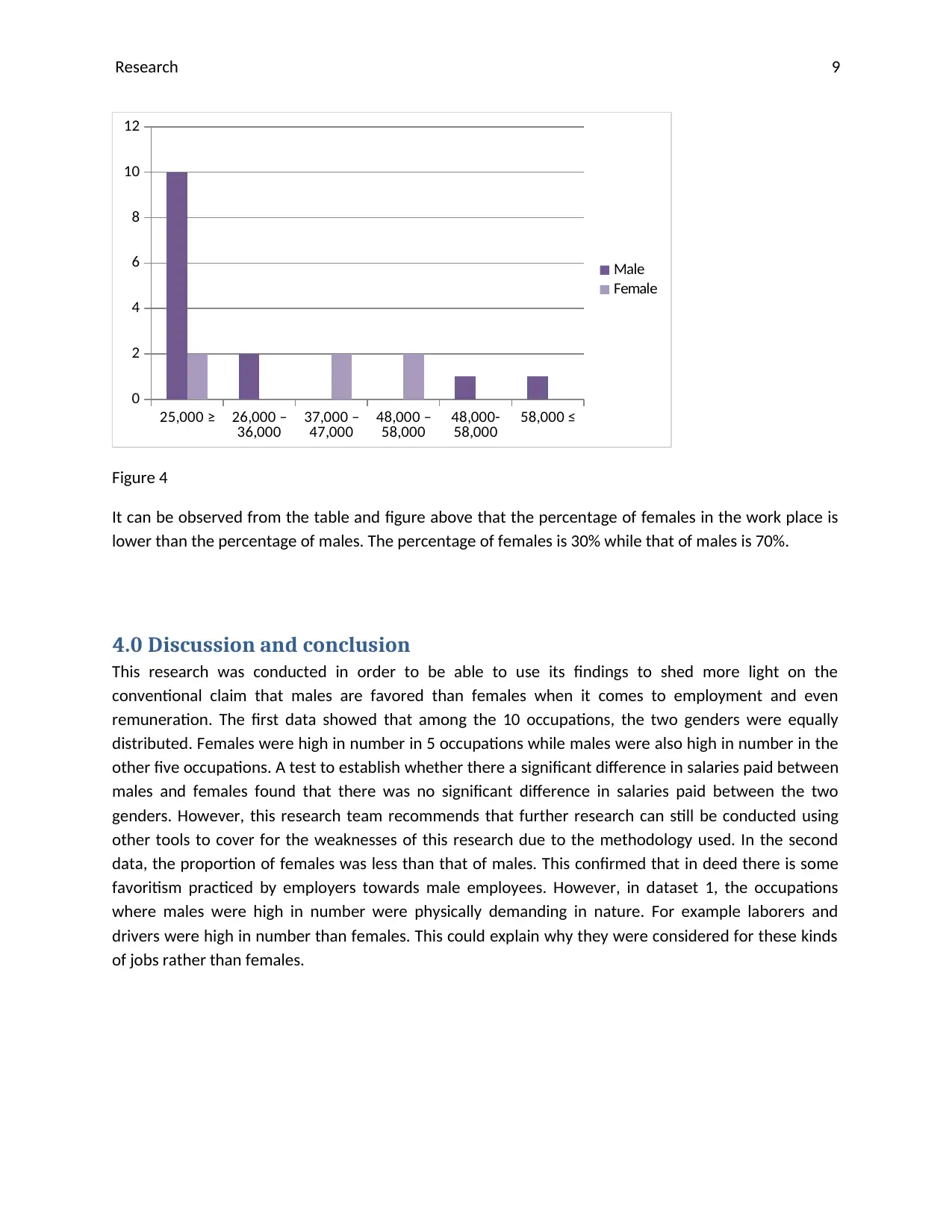
Research 9
25,000 ≥ 26,000 –
36,000 37,000 –
47,000 48,000 –
58,000 48,000-
58,000 58,000 ≤
0
2
4
6
8
10
12
Male
Female
Figure 4
It can be observed from the table and figure above that the percentage of females in the work place is
lower than the percentage of males. The percentage of females is 30% while that of males is 70%.
4.0 Discussion and conclusion
This research was conducted in order to be able to use its findings to shed more light on the
conventional claim that males are favored than females when it comes to employment and even
remuneration. The first data showed that among the 10 occupations, the two genders were equally
distributed. Females were high in number in 5 occupations while males were also high in number in the
other five occupations. A test to establish whether there a significant difference in salaries paid between
males and females found that there was no significant difference in salaries paid between the two
genders. However, this research team recommends that further research can still be conducted using
other tools to cover for the weaknesses of this research due to the methodology used. In the second
data, the proportion of females was less than that of males. This confirmed that in deed there is some
favoritism practiced by employers towards male employees. However, in dataset 1, the occupations
where males were high in number were physically demanding in nature. For example laborers and
drivers were high in number than females. This could explain why they were considered for these kinds
of jobs rather than females.
25,000 ≥ 26,000 –
36,000 37,000 –
47,000 48,000 –
58,000 48,000-
58,000 58,000 ≤
0
2
4
6
8
10
12
Male
Female
Figure 4
It can be observed from the table and figure above that the percentage of females in the work place is
lower than the percentage of males. The percentage of females is 30% while that of males is 70%.
4.0 Discussion and conclusion
This research was conducted in order to be able to use its findings to shed more light on the
conventional claim that males are favored than females when it comes to employment and even
remuneration. The first data showed that among the 10 occupations, the two genders were equally
distributed. Females were high in number in 5 occupations while males were also high in number in the
other five occupations. A test to establish whether there a significant difference in salaries paid between
males and females found that there was no significant difference in salaries paid between the two
genders. However, this research team recommends that further research can still be conducted using
other tools to cover for the weaknesses of this research due to the methodology used. In the second
data, the proportion of females was less than that of males. This confirmed that in deed there is some
favoritism practiced by employers towards male employees. However, in dataset 1, the occupations
where males were high in number were physically demanding in nature. For example laborers and
drivers were high in number than females. This could explain why they were considered for these kinds
of jobs rather than females.
⊘ This is a preview!⊘
Do you want full access?
Subscribe today to unlock all pages.

Trusted by 1+ million students worldwide
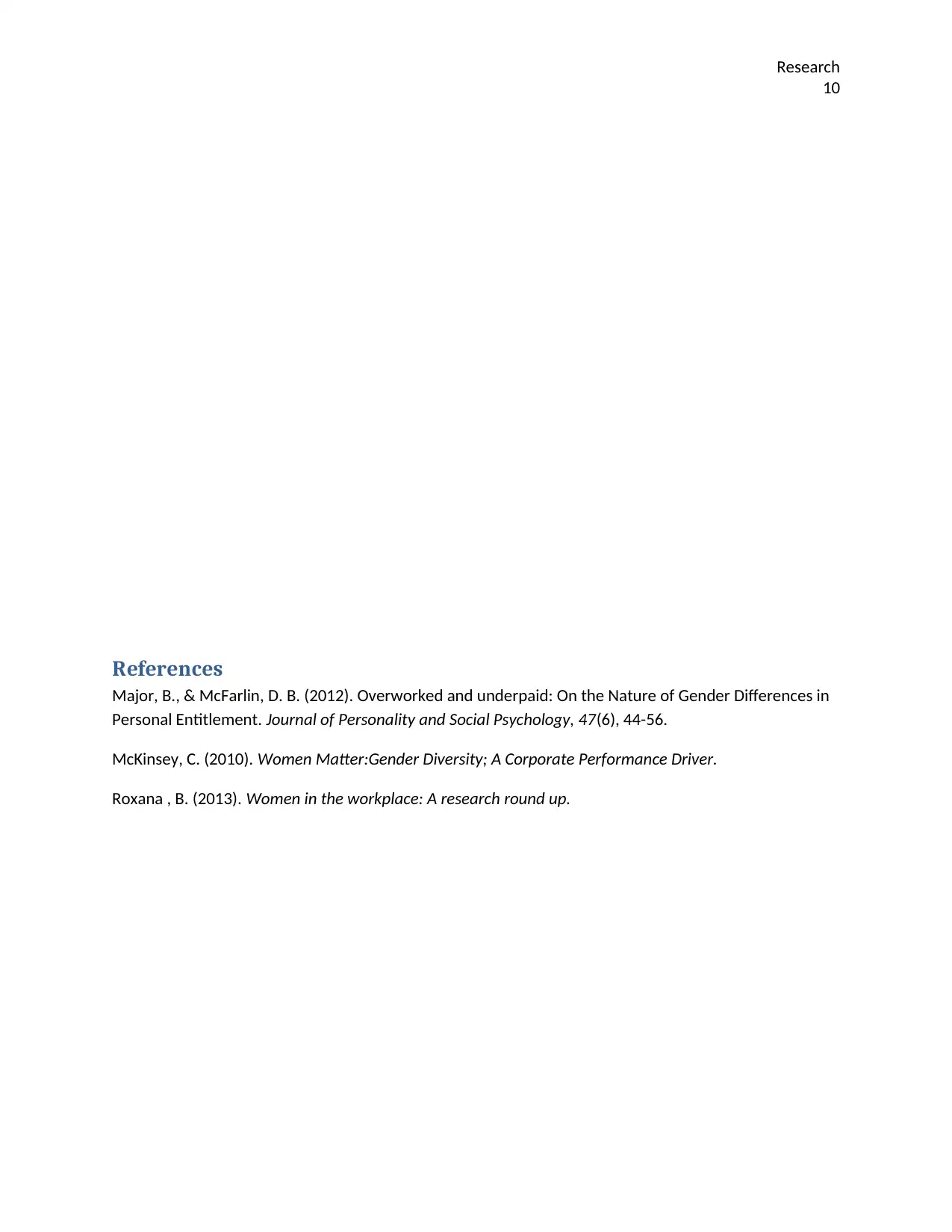
Research
10
References
Major, B., & McFarlin, D. B. (2012). Overworked and underpaid: On the Nature of Gender Differences in
Personal Entitlement. Journal of Personality and Social Psychology, 47(6), 44-56.
McKinsey, C. (2010). Women Matter:Gender Diversity; A Corporate Performance Driver.
Roxana , B. (2013). Women in the workplace: A research round up.
10
References
Major, B., & McFarlin, D. B. (2012). Overworked and underpaid: On the Nature of Gender Differences in
Personal Entitlement. Journal of Personality and Social Psychology, 47(6), 44-56.
McKinsey, C. (2010). Women Matter:Gender Diversity; A Corporate Performance Driver.
Roxana , B. (2013). Women in the workplace: A research round up.
1 out of 10
Related Documents
Your All-in-One AI-Powered Toolkit for Academic Success.
+13062052269
info@desklib.com
Available 24*7 on WhatsApp / Email
![[object Object]](/_next/static/media/star-bottom.7253800d.svg)
Unlock your academic potential
Copyright © 2020–2025 A2Z Services. All Rights Reserved. Developed and managed by ZUCOL.





